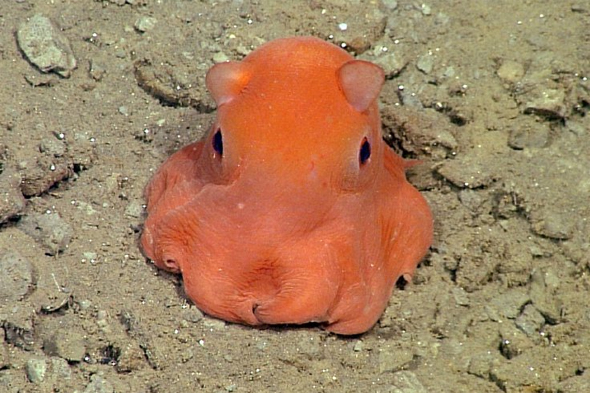Hello ladies and gents this is the Viking telling you that today we are talking about
DUMBO OCTOPUS
Grimpoteuthis is a genus of pelagic umbrella octopuses known as the dumbo octopuses. The name "dumbo" originates from their resemblance to the title character of Disney's 1941 film Dumbo, having a prominent ear-like fin which extends from the mantle above each eye. There are 13 species recognized in the genus. Prey include crustaceans, bivalves, worms and copepods. The average life span of various Grimpoteuthis species is 3 to 5 years.
Species of Grimpoteuthis are assumed to have a worldwide distribution, living in the cold, abyssal depths ranging from 1,000 to 7,000 metres. Specimens have been found off the coast of Oregon, the Philippines, Martha's Vineyard, the Azores, New Zealand, Australia, California, Gulf of Mexico, Papua, and New Guinea. Dumbo octopuses are among the deepest living octopuses known. In 2020, Grimpoteuthis was spotted ~ 7000m deep down in the Java Trench.
Threats
Species of Grimpoteuthis face few direct threats from humans, living at depths of 1,000 meters (3,300 ft) and below. Natural predators include sharks and predatory cephalopods. The Grimpoteuthis does not have an ink sac and therefore, they change colors and size due to their chromatophore cells that helps them protect themselves from predators. Some color changes can be red, white, pink, brown, or they become an invisible color so that they can blend in with the ocean floor. Besides the threats they face Grimpoteuthis feed on worms, crustaceans, shellfish, and copepods.
Movement, characteristics and food supply
The genus has a distinct habit of swimming. Whilst it appears that the large fins on the side of the head are propelling the creature, it is actually a siphon, pushing water out the back, creating propulsion. The fins are in fact primarily used for stabilization and steering. Movement of the arms can be used to help the animal move in any direction. The arms permit the animal to crawl along the seafloor, to capture prey, lay eggs, explore, etc.
Dumbos hover above the sea floor, searching for polychaete worms, pelagic copepods, isopods, amphipods, and other crustaceans for food. Prey is captured by pouncing on the target, which then is swallowed whole. It is also interesting to know that in contrast to other octopuses, dumbo octopuses do not produce ink. This makes sense considering the fact that their habitat is a deep, dark place in the ocean.
Instead of ink sacs, dumbo octopuses take advantage of a strand-like structure on their suckers to help them sense the surrounding environment as well as looking for food. The dumbo octopus has a distinct characteristic, what was once thought to be white spot(s) above their eyes, near the base of the fins is transparent patches. These patches function to detect light
And as always have a chilled day from the Viking.

Comments
Post a Comment